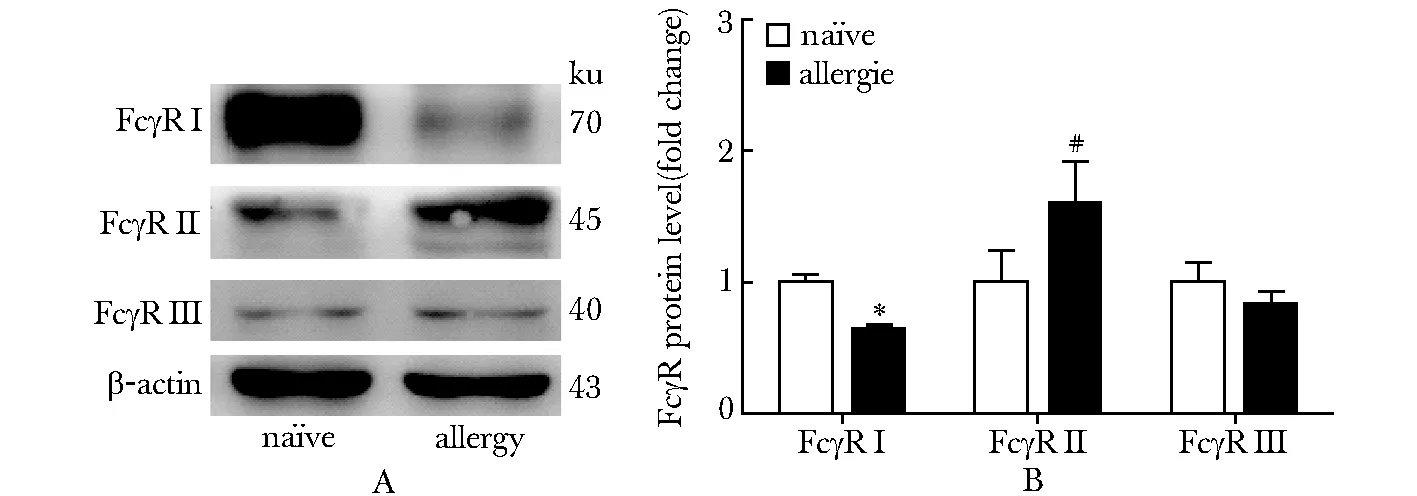Fcγ和Fcε受体在小鼠三叉神经节的表达
刘 帆,李春艳,徐鲁斌,陈纳泽,周 末,姜浩武,马 超
(中国医学科学院 基础医学研究所 北京协和医学院 基础学院 人体解剖与组织胚胎学系, 北京 100005)
研究论文
Fcγ和Fcε受体在小鼠三叉神经节的表达
刘 帆,李春艳,徐鲁斌,陈纳泽,周 末,姜浩武,马 超*
(中国医学科学院 基础医学研究所 北京协和医学院 基础学院 人体解剖与组织胚胎学系, 北京 100005)
目的检测正常小鼠三叉神经节(TG)是否表达免疫球蛋白G(IgG)和免疫球蛋白E(IgE)Fc段Fcγ受体和 Fcε受体,及其在过敏小鼠TG中的变化。方法通过腹腔注射OVA和铝剂,建立小鼠过敏性结膜炎(ACJ)模型。ELISA检测血清总IgE。用Western blot 和免疫荧光检测Fcγ受体和Fcε受体的表达。结果小鼠TG表达Fcγ受体和 Fcε受体。其中IgG激活型高亲和力受体FcγRI和抑制型低亲和力受体FcγRⅡ只表达在小鼠TG神经元上,而IgG激活型低亲和力受体FcγRⅢ表达在小鼠TG中的卫星胶质细胞上。IgE激活型高亲和力受体FcεRⅠ表达在小鼠TG神经元上,而IgE低亲和力受体FcεRⅡ同时表达在小鼠TG神经元和卫星胶质细胞上。与正常小鼠比较,ACJ小鼠的血清总IgE水平升高,TG的FcεRⅠ和FcγRⅡ表达增加(P<0.05)。而ACJ小鼠的FcεRⅡ和FcγRI表达下降(P<0.05)。FcγRⅢ在正常和ACJ小鼠TG中的表达无显著差别。结论小鼠TG表达的Fcγ和Fcε受体可能参与ACJ及其他过敏性疾病的发生和发展。
Fcγ受体;Fcε受体;免疫球蛋白G;免疫球蛋白E;过敏
Fc受体家族在适应性免疫中扮演了关键的角色。这些受体的失调可能导致包括自身免疫性疾病和过敏性疾病在内的多种疾病。Fcγ受体是IgG Fc段的受体,Fcε受体是IgE Fc段的受体,二者主要表达于免疫相关细胞的膜受体。
目前研究发现神经系统参与很多免疫相关疾病的病理生理过程[1- 2]。既往研究在大鼠背根神经节(dorsal root ganglion, DRG)伤害性感觉神经元上发现神经元表达的FcγR[3- 5]和FcεR[6]可以被IgG和IgE免疫复合物激活。本课题组曾发现在正常的大鼠足底注射IgG免疫复合物(IgG-IC)可以诱发疼痛,而足底给予大剂量正常大鼠IgG可以减轻足底注射IgG-IC诱发的疼痛[6]。过敏性结膜炎(allergic conjunctivitis, ACJ)是临床最常见的过敏性疾病之一,目前治疗上主要采用抗组胺药物,但部分患者疗效欠佳。根据本课题组和其他研究者的发现[6],推测支配眼结膜的三叉神经节(trigeminal ganglion, TG)感觉神经元表达Fcγ和ε受体,从而可能参与过敏性结膜炎导致的眼部瘙痒和疼痛症状的发生。本研究将检测在小鼠TG是否表达各型Fcγ和ε受体,及在过敏疾病状态下小鼠各型TG Fcγ和ε受体的表达变化。
1 材料与方法
1.1 材料
OVA(Sigma-Aldrich公司)。铝剂(imject alum)(Thermo公司)。RIPA裂解液、蛋白酶抑制剂、BCA蛋白定量试剂盒、ECL发光试剂盒(康为世纪公司)。仓鼠抗FcεRⅠ抗体(LifeSpan Bio公司)。兔抗FcγRⅠ抗体(Sino Bio公司)。大鼠抗FcεRⅡ抗体(Abd公司)。兔抗FcγRⅡ抗体、兔抗FcγRⅢ抗体和HRP标记的羊抗仓鼠二抗(Abcam公司)。小鼠抗β-actin抗体、HRP标记的羊抗兔IgG、羊抗大鼠IgG和羊抗小鼠IgG二抗(中杉金桥公司)。各型荧光二抗(Jackson Immuno Research公司)。
1.2 动物及ACJ动物模型制备
SPF级雄性C57小鼠,体质量20~25 g[中国食品药品检定研究院提供,许可证SCXK(京):2009- 0017]。
动物随机分为对照组和过敏模型组。其中过敏模型组按不同时间点0、7和14 d 3次腹腔注射OVA和铝剂的混合液,第21天给予1% OVA滴眼进行激发。激发24 h后,采取TG。致敏模型组小鼠眼睛被1% OVA激发,小鼠眼部处于过敏状态。
1.3 ELISA检测
按照小鼠IgE ELISA Kit(eBioscience公司)说明书操作检测对照组和过敏模型组小鼠血清中总IgE浓度。
1.4 Western blot测定
每10 mg TG组织块中加入99 μL预冷的RIPA裂解液和2 μL蛋白酶抑制剂。超声破碎,提取上清后,使用BCA法测定蛋白浓度。SDS聚乙烯酰胺凝胶电泳,湿法转膜、5%脱脂牛奶封闭。抗FcεRⅠ抗体(1∶1000)、抗FcεRⅡ抗体(1∶1 000)、抗FcγRⅠ抗体(1∶1 000)、抗FcγRⅡ抗体(1∶5 000)、抗FcγRⅢ抗体(1∶5 000)和抗β-actin(1∶800)4 ℃孵育过夜;TBST清洗3遍,加二抗,室温孵育1 h。ECL发光,应用ImageQuant LAS4000 mini成像系统显影成像。
1.5 免疫荧光
正常对照组和过敏模型组小鼠的TG在10%缓冲甲醛固定液中4 ℃固定过夜。然后浸泡在30%蔗糖溶液中并置于4 ℃脱水。待组织沉底后进行冷冻切片,片厚12 μm。正常羊血清室温封闭1 h后分别加入抗FcεR Ⅰ抗体(1∶100)、抗FcεRⅡ抗体(1∶100)、抗FcγR Ⅰ抗体(1∶150)、抗FcγRⅡ抗体(1∶200)和抗FcγRⅢ抗体(1∶150)4 ℃孵育过夜;分别加入Alexa Fluor488标记的羊抗仓鼠IgG(1∶400)、Alexa Fluor488标记的羊抗兔IgG(1∶600)和Alexa Fluor488标记的羊抗大鼠IgG(1∶500),室温孵育1 h;封片后用荧光显微镜观察。
1.6 统计学处理

2 结果
2.1 IgG Fc受体在TG表达
小鼠TG表达IgG Fc受体的FcγRⅠ、FcγRⅡ和FcγRⅢ(图1A)。IgG Fc受体的FcγR Ⅰ表达于小鼠TG的大、中和小神经元上,在卫星胶质细胞(satellite glial cells)上不表达(图1B)。FcγRⅡ与FcγR Ⅰ相同也只表达在小鼠TG神经元上(图1C)。而FcγRⅢ只表达在小鼠TG的卫星胶质细胞上,在神经元上不表达(图1D)。
2.2 IgE Fc受体在TG表达
在小鼠TG存在IgE Fc高亲和力受体FcεRⅠ和IgE Fc低亲和力受体FcεRⅡ的表达(图2A)。IgE Fc高亲和力受体FcεRⅠ只在小鼠TG神经元上表达(图2B)。而IgE Fc低亲和力受体FcεRⅡ在小鼠TG的神经元和卫星胶质细胞皆有表达(图2C)。
2.3 致敏模型小鼠外周血总IgE的表达
造模第21天,致敏模型组小鼠血清总IgE浓度为(1 980±271)ng/mL,显著高于正常组小鼠血清总IgE浓度为(243±90)ng/mL(P<0.05)。
2.4 过敏小鼠TG IgG Fc受体和IgE Fc受体的表达变化
OVA激发24 h后,在过敏小鼠的三叉神经中,IgG Fc受体的FcγR Ⅰ表达降低 (P<0.05),而FcγRⅡ表达升高 (P<0.05),FcγRⅢ表达没有变化(图3)。同正常小鼠相比,过敏小鼠三叉神经中IgE Fc受体的FcεRⅠ表达增加(P<0.05),而FcεRⅡ表达降低(P<0.05)(图4)。

A.Western blot assay of FcγRⅠ, FcγRⅡ and FcγRⅢ in TG; B.expression of FcγRI on TG neurons (arrows); C.immunofluorenscent staining of FcγRⅡ on TG neurons (arrows); D.FcγRⅢ was found on the satellite glial cells (arrows)(scale bar=25 μm)
图1 IgG Fc受体在三叉神经节表达
Fig 1 Expression of IgG Fc receptor in the TG

A.Western blot assay of FcεRⅠ and FcεRⅡ in TG; B.expression of FcεRⅠ on TG neurons; C.immunoreactivity for FcεRⅡ was found on both neurons (arrows) and satellite glial cells (arrow-heads)(scale bar=25 μm)
图2 IgE Fc受体在三叉神经节表达
Fig 2 Expression of IgE Fc receptor in the TG

A.Western blot assay for the level of FcγRⅠ, FcγRⅡ and FcγRⅢ in both allergic mice and naïve mice TG; B.data summary of the FcγRⅠ, FcγRⅡ and FcγRⅢ expression level in both allergic mice and naïve mice TG;*P<0.05 compared with naïve FcγRⅠ;#P<0.05 compared with naïve FcγRⅡ
图3 过敏小鼠IgG Fc受体在三叉神经节表达
Fig 3 Expression of IgG Fc receptor in the TG

A.Western blot assay for the level of FcεRⅠ and FcεRⅡ in both allergic mice and naïve mice TG; B.data summary of the FcεRⅠ and FcεRⅡ expression level in both allergic mice and naïve mice TG;*P<0.05 compared with naïve FcεRⅠ,#P<0.05 compared with naïve FcεRⅡ
图4 过敏小鼠IgE Fc受体在三叉神经节表达
Fig 4 Expression of IgE Fc receptor in the TG
3 讨论
本研究观察到正常小鼠TG中表达各型IgG Fc受体和IgE Fc受体。发现TG中IgG Fc受体FcγRⅠ和FcγRⅡ只表达在神经元上。而IgG Fc受体FcγRⅢ不表达在神经元上,只表达在卫星胶质细胞上。同时发现IgE Fc受体FcεRⅠ只表达在神经元上,而IgE Fc受体FcεRⅡ在神经元和卫星胶质细胞上同时都表达。在过敏小鼠TG中FcγRⅠ表达降低,而FcγRⅡ表达增加,FcγRⅢ表达无变化。FcεRⅠ在过敏小鼠TG上表达增加,而FcεRⅡ在过敏小鼠TG上表达下降。
IgG Fc受体中FcγRⅠ、FcγRⅢ和IgE Fc受体FcεRⅠ为激活型受体,主要表达在单核巨噬细胞、粒细胞和肥大细胞等免疫细胞上,都含有与Fc段结合的α亚基和包含ITAM (immunoreceptor tyrosine-based activation motif) 基序的γ亚基[7]。当免疫复合物与FcγRⅠ、FcγRⅢ或FcεRⅠ结合,给细胞以活化信号[8- 11]。FcγRⅡ为IgG的抑制型受体,其胞内为ITIM基序(immunoreceptor tyrosine-based inhibitor motif),免疫复合物与FcγRⅡ结合,激活ITIM基序,给细胞以抑制信号[8- 10]。FcεRⅡ 为IgE的低亲和力受体,主要表达在B细胞、T细胞和粒细胞上。与其他Fc受体都属于免疫球蛋白超家族不同,FcεRⅡ属于凝集素家族,主要调节IgE抗体的表达[11]。
最近研究表明,在DRG神经元中表达的FcγRⅠ和颈上神经节中的神经元表达的FcεRⅠ能够分别直接被IgG或IgE免疫复合物激活[3,12]。本实验中系统性的检测了Fcγ受体和 Fcε受体各亚型在TG中各类型细胞上的表达情况,发现在小鼠过敏后一些Fcγ受体和 Fcε受体的亚型在TG中表达发生改变。
综上所述,本实验观察到小鼠FcεRⅠ在ACJ模型TG神经元中表达增高,提示其可能参与过敏性疾病的发生,发挥类似DRG神经元上的FcγRⅠ和IgG免疫复合物结合的作用[3- 5],直接与免疫复合物结合引起神经元兴奋性增高,参与过敏性疾病的发生,导致瘙痒或疼痛。关于这些受体在TG神经元上的功能特性及其分子信号传导机制还有待进一步实验研究。
[1] Bautista DM, Wilson SR, Hoon MA. Why we scratch an itch: the molecules, cells and circuits of itch [J]. Nat Neurosci, 2014,17:175- 182.
[2] Calvo M, Dawes JM, Bennett DLH. The role of the immune system in the generation of neuropathic pain [J]. Lancet Neuro, 2012, 11:629- 642.
[3] Qu L, Zhang P, Ma C,etal. Neuronal Fc-gamma receptor Ⅰ mediated excitatory effects of IgG immune complex on rat dorsal root ganglion neurons [J]. Brain Behav and Immun, 2011, 25:1399- 1407.
[4] Qu L, Li Y, Ma C,etal. Transient Receptor Potential Canonical 3 (TRPC3) Is Required for IgG Immune Complex-Induced Excitation of the Rat Dorsal Root Ganglion Neurons [J]. J Neurosci, 2012, 32:9554- 9562.
[5] Andoh T, Kuraishi Y. Direct action of immunoglobulin G on primary sensory neurons through Fc gamma receptor I [J]. Faseb J, 2004, 18:182- 184.
[6] Andoh T, Kuraishi Y. Expression of Fc epsilon receptor I on primary sensory neurons in mice [J]. Neuroreport, 2004, 15:2029- 2031.
[7] Nimmerjahn F, Ravetch JV. Fc gamma receptors as regulators of immune responses [J]. Nat Rev Immunol, 2008, 8:34- 47.
[8] Nimmerjahn F, Ravetch JV. Fc gamma receptors: Old friends and new family members [J]. Immunity, 2006, 24:19- 28.
[9] Bezbradica JS, Rosenstein RK, Medzhitov R,etal. A role for the ITAM signaling module in specifying cytokine-receptor functions [J]. Nat Immunol, 2014, 15:333- 342.
[10] Schwab I, Nimmerjahn F. Intravenous immunoglobulin therapy: how does IgG modulate the immune system? [J]. Nat Rev Immunol, 2013, 13:176- 189.
[11] Conner ER, Saini SS. The immunoglobulin E receptor: Expression and regulation [J]. Curr Allergy Asthma Rep, 2005, 5:191- 196.
[12] van der Kleij H, Janssen L,etal. Evidence for neuronal expression of functional Fc (epsilon and gamma) receptors [J]. J Allergy Clin Immunol, 2010, 125:757- 760.
Expression of Fcγ and Fcε receptor on mouse trigeminal ganglions
LIU Fan, LI Chun-yan, XU Lu-bin, CHEN Na-ze, ZHOU Mo, JIANG Hao-wu, MA Chao*
(Dept. of Anatomy, Histology and Embryology, Institute of Basic Medical Sciences, Chinese Academy of Medical Sciences, School of Basic Medicine, Peking Union Medical College, Beijing 100005, China)
Objective To investigate the expression of Fcγ and ε receptor on mouse trigeminal ganglions and the expression change f neuronal Fcγ and ε receptor in allergy. Methods Allergy model of mouse was developed by intraperitoneal injection of OVA and Alum. ELISA was applied to identify the level of the serum total IgE in the naïve and allergic mouse. Western blotting and immunofluorescence were employed to detect the expression and the change of Fcγ and ε receptor on naïve and allergic mouse trigeminal ganglions. Results Fcγ and ε receptor were expressed on mouse trigeminal ganglions. The FcγRⅠ, the IgG high-affinity activating receptor, and FcγRⅡ that is the low-affinity inhibitory receptor FcγRⅡ only expressed on trigeminal ganglions neurons, but the IgG low-affinity activating receptor FcγRⅢ were only expressed on the satellite glial cells, not neurons of mouse trigeminal ganglions. The only IgE high-affinity activating receptor FcεRⅠ was just expressed on trigeminal ganglions neurons, but the IgE low-affinity receptor FcεRⅡ expressed on neurons and satellite glial cells of trigeminal ganglions. Compared with naïve mouse, the level of serum total IgE and the FcεRⅠ and FcγRⅡ protein of trigeminal ganglions were increased in allergic mouse. But the protein levels of trigeminal ganglions FcεRⅡ and FcγRI were decreased in allergic mouse. The expression of FcγRⅢ was not significantly differente between naïve mouse and allergic mouse trigeminal ganglions. Conclusions Fcγ and ε receptor on mouse trigeminal ganglions may be involved in the allergic desease.
Fcγ receptor; Fcε receptor; IgG; IgE; allergy
2015- 03- 13
2015- 04- 14
国家自然科学基金(81271239);中国医学科学院基础医学研究所院所长基金(2011RC01);北京协和医学院青年科研基金(201211)
1001-6325(2015)06-0729-05
R322.8
A
*通信作者(corresponding author):machao@ibms.cams.cn

